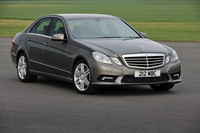Maximum EuroNCAP rating for Mercedes-Benz E-Class

The Mercedes-Benz E-Class which launched in June 2009 has achieved the highest rating of five stars in the more stringent EuroNCAP tests, firmly establishing itself as one of the world’s safest luxury saloons.
"We are very pleased about this good result. It confirms that our real-life safety concept is on track, even in standardised rating crash tests," says Prof. Rodolfo Schoneburg, Head of Passive Safety at Mercedes-Benz Cars. In line with the claim that 'One star is sufficient', Mercedes-Benz has always taken a comprehensive safety approach that reflects what actually happens in real accidents. "Real Life Safety is far more than performance in standardised crash tests or the number of onboard airbags. The innovative PRE-SAFE system for example, which improves safety shortly before an accident occurs, is not assessed at all by EuroNCAP," Schoneburg explains.
During the course of its development to date, the new E-Class has successfully come through over 150 high-speed crash tests and more than 5000 realistic crash simulations. These not only included the various impact configurations prescribed for rating tests and worldwide operating approvals, but also the in-house, Mercedes crash tests derived from accident research findings.
Safety has a long tradition at Mercedes-Benz: in August 1939 the safety pioneer Béla Barényi started working in Sindelfingen. One of his inventions was the principle of the crumple zone, which first entered series production at Mercedes-Benz as a groundbreaking innovation in 1959 and remains a basic safety feature of all modern cars to this day.
With the help of its in-house accident research function, which commenced operations in 1969, Mercedes engineers have developed several milestones in passenger car safety. Among them are the airbag and PRE?SAFE. In the anniversary year of 2009, Mercedes-Benz used the ESF 2009 research vehicle to reveal what its safety specialists are currently working on.
The EuroNCAP organisation (European New Car Assessment Programme) has made its test conditions more stringent this year. All the individual tests are separately rated and consolidated to produce an overall result. Front occupant protection accounts for 50 percent of the result, child and pedestrian protection for 20 percent each, and the new test criterion of driver assistance systems for 10 percent. One of these is ESP, which has been standard equipment in Mercedes-Benz passenger cars for many years. The test programme now also includes seat tests simulating a rear-end collision, allowing an assessment of the whiplash injury risk to the cervical vertebrae.
Excellent passive safety twinned with class leading active safety measures make the Mercedes-Benz E-Class one of the safest places to be on the road.
Attention Assist, the drowsiness detection system is fitted as standard and monitors over 70 parameters to ensure that the driver is alert and awake when behind the wheel. Adaptive Highbeam Assist and the Intelligent Light System further enhance driver and passenger safety at night and are both standard on the Avantgarde and Sport models.
Optionally available are the Lane Tracking Package, which includes Blind Spot Assist. There is also a Drivers Assistance Package, which includes the Lane Tracking Package, along with Distronic Plus, the radar assisted cruise-control that also features PreSafe Brake.




